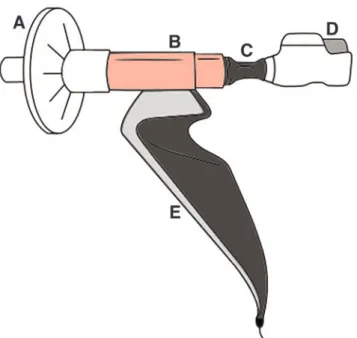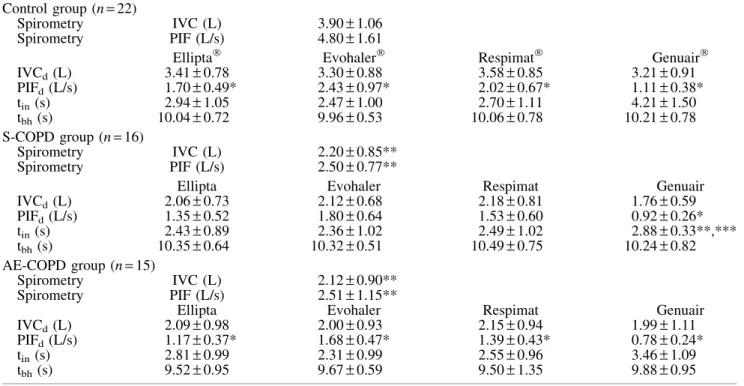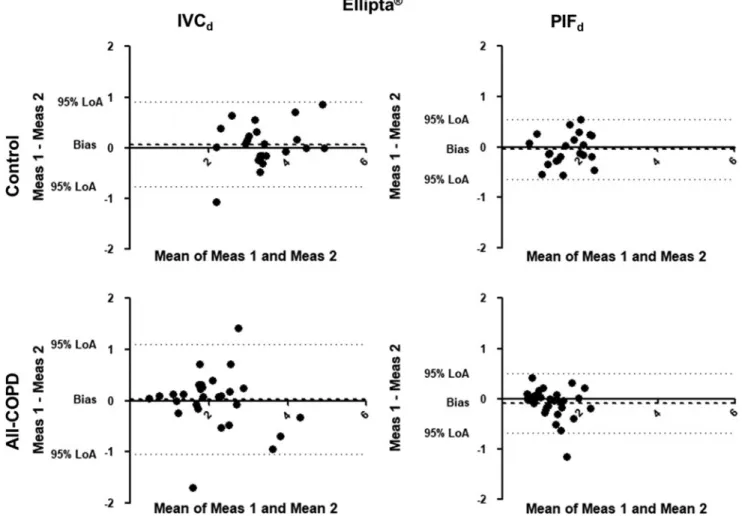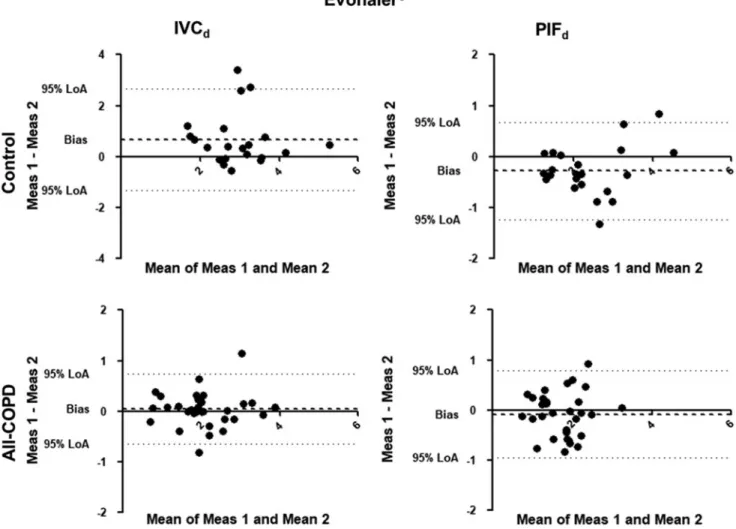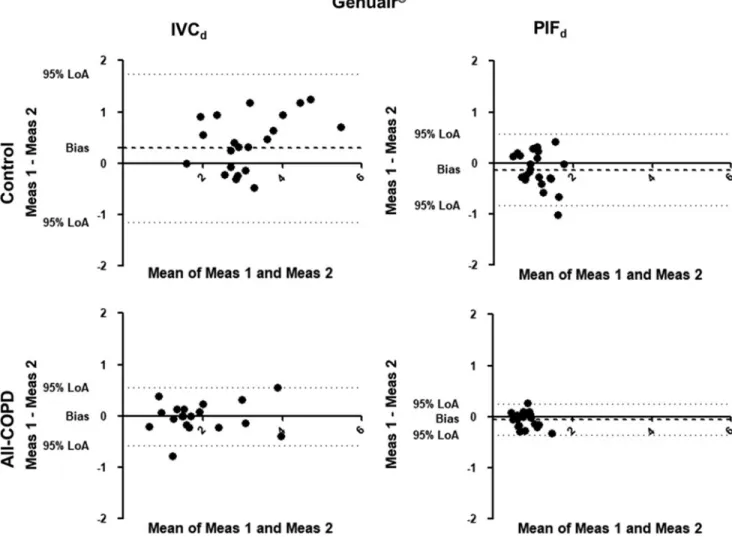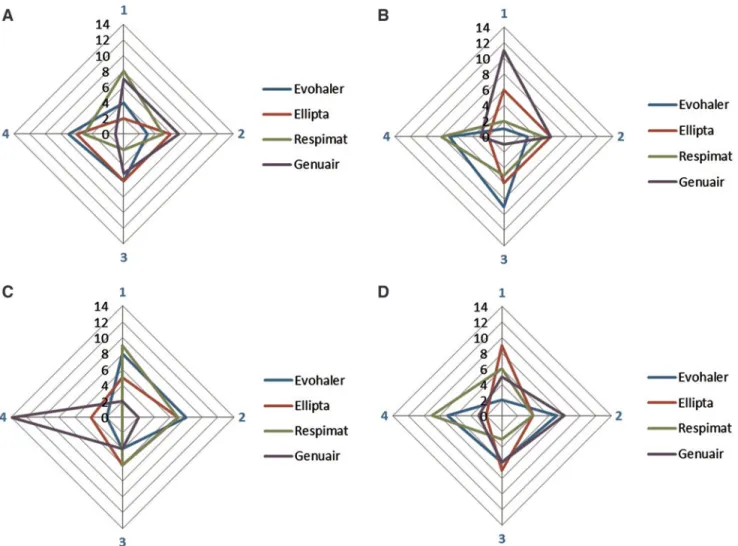The Repeatability of Inspiration Performance Through Different Inhalers in Patients with Chronic Obstructive Pulmonary Disease
and Control Volunteers
Tamas Erdelyi, MD,1,* Zsofia Lazar, MD, PhD,1,* Balazs Odler, MD, PhD,1,2 Lilla Tamasi, MD, DSc,1and Veronika Mu¨ller, MD, DSc1
Abstract
Background:
Inhalation therapy is a cornerstone of treating patients with chronic obstructive pulmonary disease (COPD). Inhaler types and through-device inhalation parameters influence airway drug delivery. We aimed to measure the repeatability of inhalation performance through four different commercially available inhalers.
Methods:
We recruited control subjects (n
¼22) and patients with stable COPD (S-COPD,
n¼16) and during an acute exacerbation (AE-COPD,
n¼15). Standard spirometry was followed by through-device inhalation maneuvers using Ellipta
, Evohaler
, Respimat
, and Genuair
. Through-device inspiratory vital capacity (IVC
d) and peak inspiratory flow (PIF
d), as well as inhalation time (t
in) and breath hold time (t
bh), were recorded and all measurements were repeated in a random manner.
Results:
There was no difference in forced expiratory volume in 1 second (FEV
1) between patients (S-COPD:
39
–5 vs. AE-COPD: 32%
–5% predicted,
p>0.05). In controls, the IVC
dwas significantly reduced by all four devices in comparison with the slight reduction seen in COPD patients. In all subjects, PIF was lowered when inhaling through the devices in order of decreasing magnitude in PIF
d: Evohaler, Respimat, Ellipta, and Genuair. The Bland-Altman analysis showed a highly variable coefficient of repeatability for IVC
dand PIF
dthrough the different inhalers for all COPD patients. Based on the intermeasurement differences in patients, Respimat and Genuair showed the highest repeatability for IVC
d, while Genuair and Ellipta performed superior with regard to PIF
d.
Conclusions:
Our study is the first to compare repeatability of inhalation performances through different inhalers in COPD patients, showing great individual differences for parameters influencing lung deposition of inhaled medication from a given device. Our data provide new insight into the characterization of inhaler use by patients with COPD, and might aid the selection of the most appropriate devices to ensure the adequate and consistent delivery of inhaled drugs.
Keywords:
COPD, exacerbation, inhalation device, inhaled therapy, repeatability
Introduction
C
hronic obstructive pulmonary disease(COPD) is associated with the progressive decline of lung function.Acute exacerbation (AE) may be triggered by a viral/bacte- rial infection or environmental pollutants. COPD AE can last
several days and it is associated with worsening of respiratory symptoms, necessitating the administration of additional therapy.(1,2)
Inhalation therapy is the cornerstone of COPD treatment in stable state and during an AE. Long-acting beta2-agonists (LABA) and long-acting muscarinic antagonist (LAMA)
1Department of Pulmonology, Semmelweis University, Budapest, Hungary.
2Clinical Division of Nephrology, Department of Internal Medicine, Medical University of Graz, Graz, Austria.
*These authors contributed equally to this work.
ªMary Ann Liebert, Inc.
Pp. 1–11
DOI: 10.1089/jamp.2020.1594
1
Downloaded by UPPSALA UNIVERSITETSBIBLIOTEK from www.liebertpub.com at 05/29/20. For personal use only.
drugs can relieve symptoms and they are recommended as first-line treatment for COPD. Patients experiencing an in- creased number of AEs may have benefit from the addition of inhaled corticosteroids (ICS).(1,3,4)
There are three basic types of commercially available inhalation devices used for pulmonary drug delivery in pa- tients with COPD. Pressurized metered-dose inhalers (pMDIs) contain a liquid medication, which is delivered as an aerosol spray. The adequate use of pMDIs can be chal- lenging to patients as it requires the harmonization of the timing of device actuation and aerosol inhalation with the correct inspiratory flow.(5) Dry powder inhalers (DPIs) re- lease a dose of dry powder, which patients have to inhale rapidly and steadily. Once the powder is loaded in the de- vice, the flow generated by the patient during inhalation is responsible for the drug release.(5,6) Furthermore, the soft- mist inhaler (SMI) provides a premeasured amount of medicine in a slow-moving mist, reducing the need of co- ordination between inhalation and inhaler actuation.(7)
The main goal of inhalation therapy is to deliver the right amount of the right drug to the right place of action within the airways.(8)It has been shown with modeling studies that inspiratory vital capacity (IVC), peak inspiratory flow (PIF), breath hold (tbh), and the time for inhalation (tin) and ex- halation during device use influence pulmonary drug depo- sition.(9–11) Furthermore, individual patient characteristics, including the anatomy of the mouth and upper and lower airways, also affect drug delivery.(12) In COPD, the actual physical condition of the patient such as the strength of inspiratory muscles and the severity of the disease can also influence the inspiratory maneuver during device use.(13)
The ease of use and patient preference are the driving factors when selecting an inhaler, but disease severity and symptom burden can also influence inhalation performance via inhalers.(14) A good repeatability of inhalation perfor- mance through a given device is a prerequisite for consistent delivery of inhaled medications to the airways and for ef- fective inhalation therapy.(15) Previous studies examined lung deposition of drug particles inhaled through different devices,(12,16,17) but data on repeatability of inhalation per- formance through different inhalers in patients with COPD are lacking. Therefore, we aimed to test the repeatability of inhalation performances in control subjects and patients with stable COPD (S-COPD) and exacerbated COPD, using four commercially available inhalers.
Materials and Methods Subjects and study design
Patients with S-COPD (n=16) were recruited during regular outpatient visits, patients with exacerbated COPD (AE-COPD, n=15) were included<72 hours after hospital admission due to an acute severe relapse. Patients had been previously diagnosed with COPD by a respiratory specialist according to the Global Initiative for Chronic Obstructive Lung Disease (GOLD) as post-bronchodilator forced expi- ratory volume in 1 second (FEV1)/FVC <0.70.(1) Therapy was decided by the treating physician, but all patients were treated with systemic steroids. Control volunteers (Control, n=22) did not have a chronic respiratory disease and were recruited from employees of the department. Individuals in the S-COPD and Control groups with acute respiratory tract
infections within 2 weeks and AE-COPD group who suf- fered from pneumonia or needed noninvasive ventilation were excluded. Subjects were recruited between April and December 2015 at the Department of Pulmonology, Sem- melweis University, Budapest, Hungary.
All procedures were performed in accordance with the 1964 Helsinki Declaration and its later amendments or comparable ethical standards. All subjects were informed about the meth- ods and aims of the measurements and signed the informed consent form. The study was approved by the Ethics Com- mittee of the Semmelweis University (TUKEB 239/2015).
Study design
The subjects attended a single visit. All patients performed standard lung function tests, which were followed by the in- halation maneuvers using at least three different inhalers after a minimum of a 30-minute break. Subjects filled out disease- specific and generic quality-of-life questionnaires.
Lung function measurements
Using an electronic spirometer and body plethysmogra- phy (PDD-301/s; Piston, Budapest, Hungary), lung function measurements were performed according to the American Thoracic Society and European Respiratory Society guide- lines.(18) Pulmonary function variables were expressed as the percentage of predicted values. None of the records was post-bronchodilator measurements.
Inhalation maneuvers through different inhalers
Four commercially available inhalers were used in our study:
two DPIs (Elliptaand Genuair), one pMDI (Evohaler), and one SMI (Respimat). Inhalers with active substances were not applied during the study.
For through-device lung function testing, an electronic spirometer was used (PDD-301/sh; Piston), which has built-in ambient temperature, pressure, and humidity sensors for the fully automatic BTPS (body temperature, pressure, water vapor saturated) correction. It is equipped with a PinkFlow flowmeter (PPF-18; Piston), which measures flow based on the principle of a symmetric and averaging Pitot tube. The flowmeter was attached to a plastic piece connecting the in- haler under testing (Fig. 1). Initially, eight commercially available devices were tested with a 3-L calibration pump at 30-60-90 L/min flow to investigate if our setup could accu- rately measure through-device flow rate. From the measured flow rate, volume was calculated. Only the four devices used in our study fulfilled the criteria for reliable flow volume measurement in our setup. The connecting piece was used to prevent an air leak and subsequent changes of measured parameters. The metal ring with a rubber overlay was at- tached to the different mouthpieces of the individual inhalers.
All measurements were performed through a bacterial filter.
Subjects were instructed for 5–10 minutes only before the measurements to explain and correct inhalation maneuvers as recommended by the manufacturers of each device. They could ask questions before measurements, but they were not allowed to practice inhalation maneuvers. Steps of the in- halation maneuver were as follows: (1) preparation of the device; (2) long exhalation; (3) attachment of the inhaler to the flexible connecting piece; (4) deep inhalation through
Downloaded by UPPSALA UNIVERSITETSBIBLIOTEK from www.liebertpub.com at 05/29/20. For personal use only.
the inhaler to total lung capacity, with optimal actuation of pMDI and SMI by the examiner and simultaneous recording of the prespecified parameters; (5) breath-holding for 10 seconds (when possible) while the inhaler device was de- tached from the connecting piece; and (6) long exhalation.
Through-device inspiratory vital capacity (IVCd) and peak inspiratory flow (PIFd) were recorded. In addition, tinand tbh were also noted. Measurements for all four devices were performed first in a random manner followed by a different second sequence in all patients and controls, including a total of six-eight recordings/subject with at least a 5-minute break between maneuvers.
Control subjects had never used an inhaler before the study, but all patients were on inhaled medication, but the types of their actual regular inhalers were not recorded.
Assessment of symptoms and quality of life
Subjects filled out the Modified Medical Research Council (mMRC) and the Hungarian version of the COPD Assessment Test (CAT).(19,20) Furthermore, the visual ana- log scale (VAS) was used, which is scaled from 0 to 10, to measure the general health condition of the participants.
A score of 0 reflected no health problems, while a poor condition was represented by a score of 10.(21)
Statistical analysis
Statistical analysis was performed using GraphPad Prism software 5 (GraphPad Software, La Jolla, CA) and SPSS Statistics V22 (International Business Machines Corpora- tion, NY). The results are expressed as the mean–standard error of the mean or median (interquartile range). One-way analysis of variance followed by Bonferroni’s multiple comparison test, or Kruskal-Wallis test with Dunn’s multi-
ple comparison test was used as appropriate. Repeatability of measurements was assessed by the Bland-Altman test.(22) Results were considered to be statistically significant when thep-value was less than 0.05 (p<0.05).
Results
Clinical characteristics of participants
Characteristics of patient groups and control volunteers are summarized in Table 1. COPD patients significantly differed from the control group with regard to age, current smoking habits, and cumulative smoking history. Patients with AE were slightly younger and had a higher proportion of current smokers but had less pack-years than S-COPD group patients.
All patients in the AE-COPD group were considered GOLD D patients as all needed hospitalization due to the relapse, and no previous category from their stable state was available.
COPD patients had a high number of comorbidities with a
FIG. 1. Measurement configuration attached to Genuair. (A) Bacterial filter, (B) flowmeter, (C) metal ring with rubber overlay, (D) inhaler device, (E) spirometer. Color images are available online.
Table1. Clinical Characteristics of Controls and Patients
Control S-COPD AE-COPD (n=22) (n=16) (n=15)
Female/male 14/8 10/6 11/4
Age (years) 44–3 66–2* 59–2*
BMI (kg/m2) 24.9–0.8 25–1.2 25.7–1.8 Smoking habit,n(%)a
Current smoker 11 (50) 5 (31.25) 10 (67) Former smoker 1 (4.5) 8 (50) 5 (33) Never smoker 10 (45.5) 3 (18.75) 0 (0)
Pack-year 18–4 50–6* 36–3*
GOLD category 2017,n(%)
A NA 2 (12.5) 0 (0)
B NA 2 (12.5) 0 (0)
C NA 5 (31) 0 (0)
D NA 7 (44) 15 (100)
Quality of life
mMRC 0 (0–0)1 2 (1–2)2* 4 (3–4)*
CAT 3 (1–7) 9 (7–22)2* 26 (15–31)*
VAS 1 (0–3)3 5 (4–5)2* 7 (5–10)4* Comorbidities, n(%)
Osteoporosis 1 (6) 4 (7)
Diabetes mellitus 1 (6) 3 (2)
Hypertension 4 (25) 2 (13)
Atherosclerosis 0 (0) 5 (33)**
Myocardial infarct 0 (0) 2 (13)
Cerebral stroke 0 (0) 4 (27)**
Maintenance COPD therapy,n(%)
ICS NA 12 (75) 14 (93)
LABA NA 15 (94) 15 (100)
LAMA NA 15 (94) 15 (100)
Theophylline NA 4 (25) 7 (47)
*p<0.05 versus Control, **p<0.05 versus S-COPD.
aChi-square test:p<0.01.
1n=21;2n=12;3n=20;4n=14.
AE-COPD, patients with exacerbated chronic obstructive pulmo- nary disease; BMI, body mass index; CAT, chronic obstructive pulmonary disease Assessment Test; GOLD, Global Initiative for Chronic Obstructive Lung Disease; ICS, inhaled corticosteroid;
LABA, long-acting beta2-agonist; LAMA, long-acting muscarinic antagonist; mMRC, modified Medical Research Council; NA, not applicable; S-COPD, patients with stable chronic obstructive pulmonary disease; VAS, visual analog scale.
Downloaded by UPPSALA UNIVERSITETSBIBLIOTEK from www.liebertpub.com at 05/29/20. For personal use only.
significantly higher number of vascular comorbidities in AE- COPD. Patients with exacerbation were more symptomatic with respect to mMRC, CAT, and VAS scores. The mainte- nance inhalation therapy was similar between patient groups, most patients being on triple therapy.
Lung function results
Lung function parameters revealed similar severe airflow obstruction and lung hyperinflation in both COPD groups,
while normal lung function parameters were noted in the Control group (Table 2).
Through-device inhalation parameters using different inhalers
IVCd, PIFd, tin, and tbh were tested for all four devices (Table 3). IVCd was lower for all devices in controls, while only a slight decrease was noted in both COPD groups. In Controls and AE-COPD, PIFd was signifi- cantly lower compared with PIF during spirometry for all devices. In S-COPD, PIFd was only significantly de- creased during inhalation through Genuair. IVCd and PIFddid not differ significantly for the individual devices between COPD groups. Inhalation time (tin) was in average between 2 and 3 seconds except for Genuair in Control and AE-COPD patients. Mean tbh was above 10 seconds in Controls and S-COPD, and slightly below the target in AE- COPD patients.
Repeatability of through-device inhalation parameters The Bland-Altman analysis was used to define the vari- ability of the inhalation maneuver parameters through a given device. Due to the limited number of patients in both groups, data from COPD patients with measurements in all devices (S-COPD and AE-COPD) were merged (All-COPD group, n=20). Significant individual differences were present in all tested devices regarding PIFd and IVCd (Figs. 2–5). The X-axis represents the mean of the two mea- surements for IVCd and PIFd, while the Y-axis shows the difference of the repeated measurements (first measurement–
second measurement).
Table2. Lung Function Values
Control S-COPD AE-COPD (n=22) (n=16) (n=15) FVC, % predicted 100–3 75–6* 63–6*
FEV1, % predicted 95–2 39–5* 32–4*
FEV1/FVC, % 80–2 43–3* 46–3*
PEF, % predicted 84–7 39–4* 32–2*
FEF25%–75%, % predicted
78–5 16–3* 16–2*
PIF, L/s 4.8–0.4 2.5–0.2* 2.5–0.3*
IVC, % predicted 98–2 70–6* 64–5*
TLC, % predicted 93–2 104–6 113–8*
TGV, % predicted 119–5 168–12* 193–15*
RV, % predicted 83–6 152–17* 192–19*
RV/TLC 0.28–0.02 0.56–0.04* 0.66–0.04*
Raw, % predicted 108–6 295–3* 297–31 *
*p<0.05 versus Control. FEF25%–75%, forced expiratory flow at 25%–75% of the pulmonary volume.
FEV1, forced expiratory volume in 1 second; FVC, forced vital capacity; IVC, inspiratory vital capacity; PEF, peak expiratory flow;
PIF, peak inspiratory flow; Raw, airway resistance; RV, residual volume; TGV, thoracic gas volume; TLC, total lung capacity.
Table3. Spirometric and Inhalation Parameters Measured Through the Different Inhalers Control group (n=22)
Spirometry IVC (L) 3.90–1.06
Spirometry PIF (L/s) 4.80–1.61
Ellipta Evohaler Respimat Genuair
IVCd(L) 3.41–0.78 3.30–0.88 3.58–0.85 3.21–0.91
PIFd(L/s) 1.70–0.49* 2.43–0.97* 2.02–0.67* 1.11–0.38*
tin(s) 2.94–1.05 2.47–1.00 2.70–1.11 4.21–1.50
tbh(s) 10.04–0.72 9.96–0.53 10.06–0.78 10.21–0.78
S-COPD group (n=16)
Spirometry IVC (L) 2.20–0.85**
Spirometry PIF (L/s) 2.50–0.77**
Ellipta Evohaler Respimat Genuair
IVCd(L) 2.06–0.73 2.12–0.68 2.18–0.81 1.76–0.59
PIFd(L/s) 1.35–0.52 1.80–0.64 1.53–0.60 0.92–0.26*
tin(s) 2.43–0.89 2.36–1.02 2.49–1.02 2.88–0.33**,***
tbh(s) 10.35–0.64 10.32–0.51 10.49–0.75 10.24–0.82
AE-COPD group (n=15)
Spirometry IVC (L) 2.12–0.90**
Spirometry PIF (L/s) 2.51–1.15**
Ellipta Evohaler Respimat Genuair
IVCd(L) 2.09–0.98 2.00–0.93 2.15–0.94 1.99–1.11
PIFd(L/s) 1.17–0.37* 1.68–0.47* 1.39–0.43* 0.78–0.24*
tin(s) 2.81–0.99 2.31–0.99 2.55–0.96 3.46–1.09
tbh(s) 9.52–0.95 9.67–0.59 9.50–1.35 9.88–0.95
*p<0.05 versus values obtained by standard spirometry; **p<0.05 versus Control group; ***p<0.05 versus AE-COPD.
IVCd, through-device inspiratory vital capacity; PIFd, through-device peak inspiratory flow; tbh, breath hold time; tin, inhalation time.
Downloaded by UPPSALA UNIVERSITETSBIBLIOTEK from www.liebertpub.com at 05/29/20. For personal use only.
We also calculated the bias (difference between the X-axis and the average mean of the two measurements for all subjects) for PIFdand IVCdin Control and All-COPD groups for each device. It shows how similar these param- eters were between the two measurements, that is, deviation from zero (one-samplet-test; Table 4). We found that PIFd
was significantly higher during the second measurement in controls inhaling through the Evohaler and Respimat, and there was a trend for higher values for the second maneuver with the Genuair. Furthermore, we found a trend for higher first IVCd through the Genuair in controls. Interestingly, there was only a tendency for higher PIFd for Genuair during the second measurement in patients, but no signifi- cant bias in PIFd or IVCd was noted for any inhaler in COPD.
The 95% limits of agreement and the coefficients of re- peatability (CR) of IVCd and PIFd through the different inhalers were high and variable in both controls and patients (Table 4). It is important to highlight that low CR represent better repeatability. Of note, the CR in COPD patients for IVCdwere the largest using Ellipta followed by Respimat.
For PIFd, CR were largest in Respimat, followed by Evo- haler in the All-COPD group.
Ranking of inhalers based on the differences between inspiratory parameters
We also ranked the four inhalers based on the differences between the two measurements of PIFdand IVCd(Fig. 6).
This figure highlights the inhalers with the smallest differ- ence (given Rank 1) in parameters between the two inspi- ratory maneuvers. Similarly to the findings based on the CR values in patients with COPD, Respimat and Genuair pro- duced the smallest intermeasurement differences for IVC, while Ellipta and Genuair showed the lowest variability for PIF measurements.
Discussion
Our work is the first to compare the profiles of maneuver repeatability through four different commercially available inhalers in COPD patients during stable states and exacer- bations. As the action of inhaled medication is highly dependent on proper lung deposition of the drugs, in- traindividual variability in inhalation maneuvers can lead to inconsistent pulmonary drug delivery and consequently to varying degrees of bronchodilation.(12,17)
FIG. 2. Bland-Altman analysis for Ellipta. The X-axis represents the mean of the two measurements for IVCdand PIFd, while the Y-axis shows the difference of the repeated measurements (first measurement–second measurement).
Each dot represents a person. The dashed line shows the average of the difference for all subjects. IVCd, through-device inspiratory vital capacity; LoA, Bland-Altman 95% limits of agreement; Meas, measurement; PIFd, through-device peak inspiratory flow.
Downloaded by UPPSALA UNIVERSITETSBIBLIOTEK from www.liebertpub.com at 05/29/20. For personal use only.
Adherence to inhaled medications in patients with ob- structive airway diseases is poor, and inhalation technique errors have remained frequent over the past 40 years.(23,24) International recommendations also emphasize the impor- tance of regular inhaler training in asthma and COPD.(1,25) Patients require detailed training from well-educated re- spiratory specialists.(1,26,27)Low adherence to COPD med- ications is a known important fact and one potential reason of the daily symptom variability of the disease.(23,28) In addition, patients’ preferences for individual devices might vary.(29)
Individual differences of inhalation breath profiles are generally used to model inhaler performance.(12,30) The most important breath profile parameters influencing pul- monary drug deposition include IVCd, PIFd, and tin.(17,31) Inhalation parameters have an impact on fine-particle frac- tion, mass median aerodynamic diameter (MMAD), as well as on emitted dose, especially in DPIs.(17,31)MMAD can be determined by measurements with a cascade impactor at different flow rates and is highly influenced by PIF. Dif- ferences between interinhalation PIFd in a given patient result in altered MMAD using DPIs, as well as differences in deposition pattern and subsequent alteration of thera-
peutic response.(31) Tbhis crucial for small-particle deposi- tion in the lungs. However, in this highly controlled setting directed by the examiner, no clinically meaningful differ- ence was noted.
A former study by Feldman et al. confirmed in a crossover setting differences in lung function improve- ment using the LABA-LAMA combination from Ellipta compared with Respimat in COPD patients, emphasizing individual response to different inhaled therapies in a particular patient.(32) To assess variability between the repeated measurements, we also analyzed data using the Bland-Altman plot. Significant individual differences were present in all tested devices in Controls and All- COPD patients. We found a significant difference for PIFd through Evohaler and Respimat in the Control group, which can be related to the limited experience of inhaler use and the good inspiratory muscle function of these volunteers. Notably, despite the high through-device var- iability of PIFdand IVCdin COPD as shown by the high CR values, the biases between the two measurements were not statistically significant in COPD. This might be ex- plained by the previous experience of patients with in- haled therapy.
FIG. 3. Bland-Altman analysis for Evohaler. The X-axis represents the mean of the two measurements for IVCdand PIFd, while the Y-axis shows the difference of the repeated measurements (first measurement–second measurement). Each dot represents a person. The dashed line shows the average of the difference for all subjects.
Downloaded by UPPSALA UNIVERSITETSBIBLIOTEK from www.liebertpub.com at 05/29/20. For personal use only.
According to our and previous data,(34) intrasubject re- peatability in the breath profile is an important factor for therapeutic success. However, lung deposition might differ using different inhalers, drug formulations, and the quality of the produced aerosol as well as its sensitivity to breath profile.(5,8,33–36) In addition, variabilities between batches, inhaler types, and doses are also important quality attributes to inhaler performance. Our study focused on one possible influencing factor: the repeatability of inhalation maneuvers.
We are aware of the limitations of this study; however, this is the first investigation recording at least two consecutive maneuvers using four different inhalers in a COPD patient or healthy volunteer.
In COPD patients, meaningful individual differences for all inhalers were noted without any specific change at- tributable to disease severity. Examining the through- device measurements in COPD patients, it can be observed that the repeatability of IVCdand PIFdresults in a different sequence of devices in each patient (Fig. 6). IVCddiffer- ence was the smallest in COPD patients using Respimat and Genuair. However, in some patients, these only ranked at the third and fourth place, showing the individual, not predictable, sequence of inhalers. For PIFd, Genuair and Ellipta reached the best rankings, again the individual
ranking of inhalers presented marked differences. These data support the clinical observation and the recommen- dation of the GOLD document for switching the inhaler device or molecules within the same class when therapy is considered ineffective.(1)However, no suggestion is given regarding which other device or molecules should be prescribed.
AE of COPD can last several days, and the acute wors- ening of symptoms necessitates additional therapy. Im- portantly, AEs are more common in patients with more critical inhaler handling errors.(27) It is difficult to assess though, if previous maintenance medication was properly used in our patients. The majority of patients in our AE study population used triple therapy (ICS, LABA, and LAMA) and theophylline. However, despite high treatment intensity, most patients were symptomatic. Symptom relief is the most important treatment result from a patient’s per- spective and a decrease in symptoms can decrease health care utilization.(37)In the exacerbating symptomatic patient group on triple therapy, there is no real possibility to further increase the intensity of inhaled therapy, but an optimal choice from the available inhalation devices can be offered.
As changes of devices may decrease adherence, it would be useful to measure upfront which inhaler is best suited for a FIG. 4. Bland-Altman analysis for Respimat. The X-axis represents the mean of the two measurements for IVCdand PIFd, while the Y-axis shows the difference of the repeated measurements (first measurement–second measurement). Each dot represents a person. The dashed line shows the average of the difference for all subjects.
Downloaded by UPPSALA UNIVERSITETSBIBLIOTEK from www.liebertpub.com at 05/29/20. For personal use only.
given patient.(32,38,39) This is further emphasized by the measurements performed in healthy volunteers, where the correlation of inhalation parameters was less optimal, es- pecially using inhalers where actuation of device and in- halation needs coordination.
Our study has limitations as well. It is important to mention that only two sets of measurements were performed limiting the power of the study. A small number of patients were included in the study because of the strict inclusion criteria. In addition, only four inhalers were used, as other devices FIG. 5. Bland-Altman analysis for Genuair. The X-axis represents the mean of the two measurements for IVCdand PIFd, while the Y-axis shows the difference of the repeated measurements (first measurement–second measurement). Each dot represents a person. The dashed line shows the average of the difference for all subjects.
Table4. Repeatability of Through-Device Inhalation Parameters
n
Control group
n
All-COPD group
Bias p* 95% LoA CR Bias p* 95% LoA CR
IVCd, L
Ellipta 22 0.068 0.47 -0.772–0.907 –0.831 30 0.026 0.80 -1.056–1.109 –1.066 Evohaler 22 0.049 0.44 -0.522–0.620 –0.566 31 0.048 0.46 -0.643–0.739 –0.686 Respimat 22 0.040 0.45 -0.432– 0.511 –0.467 31 -0.075 0.33 -0.900–0.751 –0.828 Genuair 22 0.294 0.08 -1.156–1.743 –1.528 20 0.014 0.83 -0.586–0.558 –0.558 PIFd,L/s
Ellipta 22 -0.049 0.47 -0.651–0.554 –0.596 30 -0.095 0.10 -0.692–0.502 –0.616 Evohaler 22 -0.282 0.01 -1.235–0.671 –1.083 31 -0.085 0.30 -0.961–0.790 –0.877 Respimat 22 -0.319 0.002 -1.170–0.532 –1.041 31 -0.128 0.20 -1.198–0.941 –1.082 Genuair 22 -0.135 0.09 -0.833–0.564 –0.731 20 -0.063 0.09 -0.367–0.242 –0.321
*p-Value for one-samplet-test of the bias.
CR, coefficients of repeatability; LoA, Bland-Altman 95% limits of agreement;n, number of subjects.
Significant differences are highlighted in bold.
Downloaded by UPPSALA UNIVERSITETSBIBLIOTEK from www.liebertpub.com at 05/29/20. For personal use only.
showed distortion in through-device volume and flow mea- surements in our setup (e.g., Turbuhaler, Breezhaler, Easyhaler, and HandiHaler). However, future studies should aim a higher sample size and the inclusion of more inhalers available on the market. Furthermore, our measure- ment method should be also tested to aid in the context of predicting the pulmonary deposition of inhaled drugs.
Conclusions
This study provides new evidence that inhalation pa- rameters through different inhalers show considerable in- trasubject and interdevice variability in healthy subjects and COPD patients. We found that some individuals may use specific devices more easily and more reliably.
Therefore, to ensure effective inhalation therapy and symptom relief, it is of great importance to optimize in- haler technique individually, especially in patients with COPD independent of disease stability or exacerbation.
Our data indicate that in COPD patients, Respimat and Genuair are ranked first and second in most patients with regard to interinhalation variability in IVCd, while Gen-
uair and Ellipta ranked highest in most patients for PIFd. These observations could potentially provide relevant in- formation to guide the switch of inhaler devices when therapy fails in patients with COPD.
Acknowledgment
The authors are thankful to Sa´ndor Nya´gu´j for performing the plethysmography measurements.
Author Disclosure Statement
M.V. and T.L. received consultation fees from Chiesi Hungary, Berlin Chemie Menarini, Boehringer Ingelheim, and Glaxo Smith Kline. All other authors have no conflict of interest to declare.
Funding Information
This work was supported by KTIA_AIK_12_1_2012_
0019 and the Bolyai Research Grant of the Hungarian Academy of Sciences (BO/00559/16 to Dr. Zso´fia La´za´r).
FIG. 6. Repeatability sequence summary for the four inhalers.(A)All-COPD IVCd(n=20).(B)All-COPD PIFd(n=20).
(C)Control IVCd(n=22).(D)Control PIFd(n=22). By each control subject and patient, a rank number between 1 and 4 was associated with each inhaler regarding the magnitude of the difference between the two values for PIFdand IVCd, respectively.
Rank 1 was given to the device with the lowest difference between the two inspiratory measurements followed by Rank 2, 3, and 4. On the figure, rank numbers are shown by four edges of the axes with blue color, and the sum of subjects with a certain rank is indicated on the axes. COPD, chronic obstructive pulmonary disease. Color images are available online.
Downloaded by UPPSALA UNIVERSITETSBIBLIOTEK from www.liebertpub.com at 05/29/20. For personal use only.
References
1. GOLD. Global Strategy for the diagnosis, management and prevention of chronic obstructive pulmonary disease:
Available from: wwwgoldcopdorg, 2019.
2. Li J, Sun S, Tang R, Hong Q, Huang Q, Mason TG, and Tian L: Major air pollutants and risk of COPD exacerba- tions: A systematic review and meta-analysis. Int J Chron Obstruct Pulmon Dis. 2016:11:3079–3091.
3. Lipson DA, Barnhart F, Brealey N, Brooks J, Criner GJ, Day NC, Dransfield MT, Halpin DMG, Han MK, Jones CE, Kilbride S, Lange P, Lomas DA, Martinez FJ, Singh D, Tabberer M, Wise RA, and Pascoe SJ: Once-daily single- inhaler triple versus dual therapy in patients with COPD.
N Engl J Med. 2018;378:1671–1680.
4. Papi A, Vestbo J, Fabbri L, Corradi M, Prunier H, Cohuet G, Guasconi A, Montagna I, Vezzoli S, Petruzzelli S, Scuri M, Roche N, and Singh D: Extrafine inhaled triple therapy versus dual bronchodilator therapy in chronic obstructive pulmonary disease (TRIBUTE): A double-blind, parallel group, randomised controlled trial. Lancet. 2018;391:1076–
1084.
5. Haidl P, Heindl S, Siemon K, Bernacka M, and Cloes RM:
Inhalation device requirements for patients’ inhalation maneuvers. Respir Med. 2016;118:65–75.
6. Dal Negro RW: Dry powder inhalers and the right things to remember: A concept review. Multidiscip Respir Med.
2015;10:13.
7. Hodder R, and Price D: Patient preferences for inhaler devices in chronic obstructive pulmonary disease: Experi- ence with Respimat Soft Mist inhaler. Int J Chron Obstruct Pulmon Dis. 2009;4:381–390.
8. Berlinski A: Assessing new technologies in aerosol medi- cine: Strengths and limitations. Respir Care. 2015;60:833–
847; discussion 847–839.
9. Lippmann M, and Albert RE: The effect of particle size on the regional deposition of inhaled aerosols in the human respiratory tract. Am Ind Hyg Assoc J. 1969;30:257–275.
10. Pavia D, Thomson M, Clarke S, and Shannon H: Effect of lung function and mode of inhalation on penetration of aerosol into the human lung. Thorax. 1977;32:194–197.
11. Palmes ED: Measurement of pulmonary air spaces using aerosols. Arch Intern Med. 1973;131:76–79.
12. Ciciliani AM, Langguth P, and Wachtel H: In vitro dose comparison of Respimat((R)) inhaler with dry powder in- halers for COPD maintenance therapy. Int J Chron Obstruct Pulmon Dis. 2017;12:1565–1577.
13. Takemura M, Mitsui K, Itotani R, Ishitoko M, Suzuki S, Matsumoto M, Aihara K, Oguma T, Ueda T, Kagioka H, and Fukui M: Relationships between repeated instruction on inhalation therapy, medication adherence, and health status in chronic obstructive pulmonary disease. Int J Chron Obstruct Pulmon Dis. 2011;6:97–104.
14. Usmani OS: Choosing the right inhaler for your asthma or COPD patient. Ther Clin Risk Manag. 2019;15:461–472.
15. Chrystyn H, van der Palen J, Sharma R, Barnes N, Delafont B, Mahajan A, and Thomas M: Device errors in asthma and COPD: Systematic literature review and meta-analysis.
NPJ Prim Care Respir Med. 2017;27:22.
16. Hamilton M, Leggett R, Pang C, Charles S, Gillett B, and Prime D: In vitro dosing performance of the ELLIPTAdry powder inhaler using asthma and COPD patient inhalation profiles replicated with the electronic lung (eLung).
J Aerosol Med Pulm Drug Deliv. 2015;28:498–506.
17. Jokay A, Farkas A, Furi P, Horvath A, Tomisa G, and Balashazy I: Computer modeling of airway deposition distribution of Foster((R)) NEXThaler((R)) and Ser- etide((R)) Diskus((R)) dry powder combination drugs. Eur J Pharmaceut Sci. 2016;88:210–218.
18. Miller MR, Hankinson J, Brusasco V, Burgos F, Casaburi R, Coates A, Crapo R, Enright P, van der Grinten CP, Gustafsson P, Jensen R, Johnson DC, MacIntyre N, McKay R, Navajas D, Pedersen OF, Pellegrino R, Viegi G, Wanger J, and Force AET: Standardisation of spirometry. Eur Re- spir J. 2005;26:319–338.
19. Jones PW, Harding G, Berry P, Wiklund I, Chen WH, and Kline Leidy N: Development and first validation of the COPD Assessment Test. Eur Respir J. 2009;34:648–654.
20. Bestall JC, Paul EA, Garrod R, Garnham R, Jones PW, and Wedzicha JA: Usefulness of the Medical Research Council (MRC) dyspnoea scale as a measure of disability in patients with chronic obstructive pulmonary disease. Thorax. 1999;
54:581–586.
21. Brooks R: EuroQol: The current state of play. Health Pol- icy. 1996;37:53–72.
22. Bland JM, and Altman DG: Statistical methods for asses- sing agreement between two methods of clinical measure- ment. Lancet. 1986;1:307–310.
23. Vestbo J, Anderson JA, Calverley PM, Celli B, Ferguson GT, Jenkins C, Knobil K, Willits LR, Yates JC, and Jones PW: Adherence to inhaled therapy, mortality and hospital admission in COPD. Thorax. 2009;64:939–943.
24. Sanchis J, Gich I, and Pedersen S: Systematic review of errors in inhaler use: Has patient technique improved over time? Chest. 2016;150:394–406.
25. GINA. Global Strategy for Asthma Management and Pre- vention: Available from: wwwginasthmaorg, 2019.
26. van Boven JFM, Lavorini F, Dekhuijzen PNR, Blasi F, Price DB, and Viegi G: Urging Europe to put non- adherence to inhaled respiratory medication higher on the policy agenda: A report from the First European Congress on Adherence to Therapy. Eur Respir J. 2017;49:1700076.
27. Molimard M, Raherison C, Lignot S, Balestra A, Lamarque S, Chartier A, Droz-Perroteau C, Lassalle R, Moore N, and Girodet PO: Chronic obstructive pulmonary disease exac- erbation and inhaler device handling: Real-life assessment of 2935 patients. Eur Respir J. 2017;49:1601794.
28. Dhamane AD, Schwab P, Hopson S, Moretz C, Annavar- apu S, Burslem K, Renda A, and Kaila S: Association be- tween adherence to medications for COPD and medications for other chronic conditions in COPD patients. Int J Chron Obstruct Pulmon Dis. 2017;12:115–122.
29. Ding B, Small M, Scheffel G, and Holmgren U: Main- tenance inhaler preference, attribute importance, and sat- isfaction in prescribing physicians and patients with asthma, COPD, or asthma–COPD overlap syndrome con- sulting for routine care. Int J Chron Obstruct Pulmon Dis.
2018;13:927–936.
30. Colthorpe P, Voshaar T, Kieckbusch T, Cuoghi E, and Jauernig J: Delivery characteristics of a low-resistance dry- powder inhaler used to deliver the long-acting muscarinic antagonist glycopyrronium. J Drug Assess. 2013;2:11–16.
31. Farkas A, Jokay A, Balashazy I, Furi P, Muller V, To- misa G, and Horvath A: Numerical simulation of emitted particle characteristics and airway deposition distribu- tion of Symbicort((R)) Turbuhaler((R)) dry powder fixed combination aerosol drug. Eur J Pharmaceut Sci. 2016;
93:371–379.
Downloaded by UPPSALA UNIVERSITETSBIBLIOTEK from www.liebertpub.com at 05/29/20. For personal use only.
32. Feldman GJ, Sousa AR, Lipson DA, Tombs L, Barnes N, Riley JH, Patel S, Naya I, Compton C, and Alcazar Navarrete B: Comparative efficacy of once-daily umeclidinium/
vilanterol and tiotropium/olodaterol therapy in symptomatic chronic obstructive pulmonary disease: A randomized study.
Adv Ther. 2017;34:2518–2533.
33. Mitchell J, Newman S, and Chan HK: In vitro and in vivo aspects of cascade impactor tests and inhaler performance:
A review. AAPS PharmSciTech. 2007;8:E110.
34. Ivancso I, Bocskei R, Muller V, and Tamasi L: Extrafine inhaled corticosteroid therapy in the control of asthma.
J Asthma Allergy. 2013;6:69–80.
35. Muller V, Galffy G, Eszes N, Losonczy G, Bizzi A, Nicolini G, Chrystyn H, and Tamasi L: Asthma control in patients receiving inhaled corticosteroid and long-acting beta2- agonist fixed combinations. A real-life study comparing dry powder inhalers and a pressurized metered dose inhaler ex- trafine formulation. BMC Pulmon Med. 2011;11:40.
36. Muller V, Galffy G, Orosz M, Kovats Z, Odler B, Selroos O, and Tamasi L: Characteristics of reversible and nonre- versible COPD and asthma and COPD overlap syndrome patients: An analysis of salbutamol Easyhaler data. Int J Chron Obstruct Pulmon Dis. 2016;11:93–101.
37. Ding B, Small M, Bergstrom G, and Holmgren U: COPD symptom burden: Impact on health care resource utiliza-
tion, and work and activity impairment. Int J Chron Ob- struct Pulmon Dis. 2017;12:677–689.
38. Laube BL, Janssens HM, de Jongh FH, Devadason SG, Dhand R, Diot P, Everard ML, Horvath I, Navalesi P, Voshaar T, and Chrystyn H: What the pulmonary specialist should know about the new inhalation therapies. Eur Respir J. 2011;37:1308–1331.
39. Leiner S, Parkins D, and Lastow O: Inhalation devices and patient interface: Human factors. AAPS J. 2015;17:457–461.
Received on January 13, 2020 in final form, April 7, 2020 Reviewed by:
Bo Olsson Address correspondence to:
Zsofia Lazar, MD, PhD Department Pulmonology Semmelweis University 25–29 Tomo Street Budapest 1083 Hungary E-mail:lazar.zsofia@med.semmelweis-univ.hu
Downloaded by UPPSALA UNIVERSITETSBIBLIOTEK from www.liebertpub.com at 05/29/20. For personal use only.
